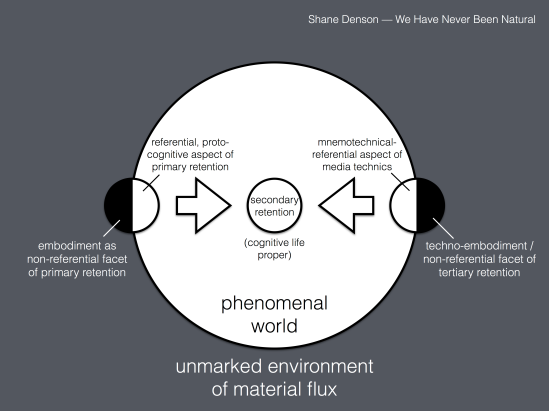Both aesthetically and conceptually, the diagram above is imperfect in many ways. It is, necessarily, an oversimplification; I hope that it might nevertheless serve a positive purpose by giving visible form to an otherwise somewhat abstract argument. Developed for my talk at the upcoming “Philosophy After Nature” conference in Utrecht (you can find my abstract here), the diagram could also serve as an emblem for the argument I make in Chapter 6 of Postnaturalism. In that chapter, I look at (among other things) Mark Hansen’s concept of “the medium as an environment for life” (as introduced in his paper “Media Theory,” which appeared in Theory, Culture & Society); this concept, developed in conversation with Bernard Stiegler’s philosophy of technics, has been very important for my work, and grappling with it was central for me in the process of arguing that “we have never been natural.”
In the course of developing his concept, Hansen argues that there is an asymmetrical priority of human embodiment in the transductive relation between technics and the human. In Hansen’s engagement with Stiegler, this prerogative of embodiment is seen to be at odds, to a certain extent, with Stiegler’s argument about the synchronization or industrialization of experience through the action of recording technologies. The latter embody “tertiary retentions” of experience, beyond the primary and secondary retentions that Husserl theorized as the operations, respectively, of immediate temporal experience and of recollection or memory. According to Stiegler, in a complex argument that I will not try to summarize here, tertiary retention (technical recording) injects secondary retention (memory) into primary retention (the immediate experience of the “adherent present,” from which flows also the future) — effectively instituting a pre-formatted future on a mass scale (especially in the age of live television and real-time media).
Following an objection raised by Jean-Michel Salanskis, who sees a paradox or split in Husserl’s notion of primary retention — a split between the referential aspect that aligns primary retention with conscious experience, on the one hand, and a non-referential aspect that is wholly unconscious, on the other — Hansen argues that Stiegler’s argument diminishes the robust role of embodiment in the production of temporal experience. The synchronization envisioned by Stiegler is dependent, according to Hansen, on a bracketing of embodied agency; the “mnemotechnical constitution of time” prioritized by Stiegler is thus secondary to the “corporo-technical constitution of time” that Hansen identifies as an infra-empirical condition of experience. Hence the asymmetrical privileging of human embodiment in the medial transduction of human and technical agencies.
The diagram above summarizes my own intervention in the context of these debates. Rather than reinstituting the priority of the human within the anthropotechnical transduction, my suggestion is that we conceive tertiary retention (and media technics more generally) as similarly split between a referential (“mnemotechnical” or broadly representational) and a non-referential (materially embodied) aspect. With memory flanked on both sides by a non-discrete, smooth space of matter, cognitive life is then situated squarely in a realm staked out between robustly material agencies—between the subpersonal operation of the body, on the one hand, and the subphenomenal, infra-empirical material agency of technics on the other. As the diagram tries to indicate, a certain symmetry is restored in the anthropotechnical interface, which on this model describes the joint production of empirical reality — the distributed (human and nonhuman) agency by which the phenomenal realm is demarcated from out of the unmarked environment of material flux.
